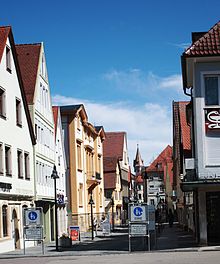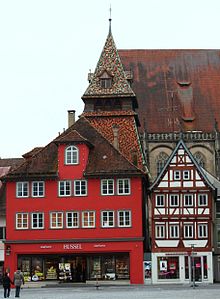Bocksgasse (Schwäbisch Gmünd)
The Bockgasse is a street in the old town of Schwabisch Gmund . The historically significant street extends east-west from the Schwäbisch Gmünder Marktplatz to the Josefsbach and crosses the Johannisplatz .
History and meaning
The Bocksgasse was one of the central traffic axes in Schwäbisch Gmünd. It connected the Gmünd market square to the lower Rems valley . This position favored their development, for example with restaurants and shops , and there are also important town buildings such as the Palais Debler in this alley. It is divided into two parts due to the former city wall rings. The first part in the inner city wall ring extends from the market square to the tournament ditch and was initially called Kirchgasse , then later Predigergasse and Johannisgasse . The first Bockstor from the 12th / 13th Century. The second part of Bocksgasse was initially called Eytikofer- or Utingkofergasse and then from 1831 onwards, after an inn in this alley, Bocksgasse. Both parts have been called Bocksgasse since 1886. In the 16th century, processions regularly ran through Bocksgasse from Lorch Abbey to Schwäbisch Gmünd and vice versa, and the street was also a frequent part of processional routes later on. Until 1966, a procession through Bocksgasse to the pilgrimage site of St. Salvator , which has its origins in the 17th century, was held annually on Rochustag . Because in 1635 the plague broke out in Bocksgasse. It was due to this fact that until 1793 music and dance were forbidden in Bocksgasse.
The first pedestrian zone in Gmünd was set up in the second half of the 20th century in Bocksgasse . Between Marktplatz and Johannisplatz, it is used for the market events taking place on the squares.

Formative structures
A large number of the buildings in Bocksgasse are protected as architectural monuments. Below there are various plastered half-timbered houses and those with visible frameworks.
Johanniskirche
Johannisplatz with the Mayor Storr House
Preacher Church
Cafè am Palais (Bocksgasse 14)
The building at Bocksgasse 14 (formerly Café Greiner ) is a building with exposed framework from the 18th century. Renovations took place in 1834, 1872, 1892 and 1939. In 1969/70 an arcade was installed for what was then Café Greiner. The house was last renovated in 2000.
Goldener Adler (Bocksgasse 15)
The former Gasthaus zum Goldenen Adler is a three-storey plastered half-timbered building. It was created in 1392/93 by assembling two older houses. and was rebuilt several times, for example in 1887, 1935 and 1979. The window band with wooden reliefs was designed by the sculptor Jakob Wilhelm Fehrle in 1935. The golden eagle sculpture typical of the time as a tavern temple above the entrance also dates from this time. The windows with stained glass were made by Georg Schmetzer and Franz Xaver Zettler from Munich.
Green House (Bocksgasse 18)
The green house, which is now painted pink, owes its name to the color scheme in the 18th century. The stately, plastered half-timbered house was built in 1658 by Friedrich Vogt, the son of the Gmünd master builder Kaspar Vogt . Before it was owned by the Debler family, it was the restaurant that gave the street its current name, which later moved to the property opposite. A plague cross that had been preserved in the Green House was brought to the Preacher's museum in 1958 .
Palais Debler
Motherhouse (Bocksgasse 20/22)
The building was built in 1782 by Gmünd city architect Johann Michael Keller the Younger for a merchant . After the Vincentian Sisters, who came to Schwäbisch Gmünd in 1852, were initially accommodated in the Gmünder Spital , they acquired the building. In 1860 it was converted into the mother house, in 1864 a refectory and a kitchen were added and in 1874 a house chapel was set up. In 1891 the motherhouse was relocated to Untermarchtal , the motherhouse in Gmünd served as an old people's home and was only given up in the 1970s by the sisters. In 1977 it was completely redesigned, and in 1978 the chapel was demolished. The house housed various works of art, most of which are now kept in Untermarchtal. The early wooden figures probably originally came from the Gmünder infirmary St. Katharina and reached the mother house via the Heiliggeistspital, namely a Pietà (17th / 18th century), a figure of Saint Catherine of Siena and one of Saint Roch (each around 1480 / 90). These are now kept in St. Anna in Schwäbisch Gmünd. A figure of Christ the King from the 16th century, originally from the Gmünder pilgrimage site of St. Salvator , a statue of the Virgin Mary from the 17th century and other old and newer art objects such as the stained glass by Wilhelm Geyer were transferred to Untermarchtal. The entire ensemble extended over the building at Bocksgasse 22 to Pfeifergässle. At Pfeifergässle, a boarding school for the sisters was built in 1874, which was replaced by a new L-shaped building in 1956.
The owner who bought the ensemble in 1976 invested little. The condition worsened. After the owner's bankruptcy , the sisters bought the area back in 2010 and renovated it. Some of the buildings were demolished and replaced by new buildings. The inauguration took place in 2015.
Torbäckerei (Bocksgasse 38)
The building that dominates the western entrance of the alley dates in part from the 17th century and the 18th century. The facade contains elements of the Renaissance style . Partially renovated in 1954, it burned down in 1976 and was rebuilt in 1984 in its current appearance.
Next to it is the entrance to Bocksgasse, which characterizes the Forstersche Villa.
Synagogue monument
At the end of Bocksgasse in front of Josefsbach, a staircase-shaped monument was inaugurated on November 9, 2015, which is a true-to-scale replica of the former access stairs to the former synagogue. In front of the memorial are the names of the members of the former Jewish community embedded in the ground. From the stairs you have a view of the location of the former synagogue on the other side of the Josefsbach on Sparkassenplatz.
literature
- Richard Strobel: The art monuments of the city of Schwäbisch Gmünd. Volume 3: Secular buildings in the old town without city fortifications , Deutscher Kunstverlag, Munich 1995, ISBN 3-422-00570-6 , pp. 33–61.
Web links
Individual evidence
- ↑ Inaugurated: The motherhouse in Bocksgasse , from January 21, 2015 on remszeitung.de.
- ↑ Reminder to the Schwäbisch Gmünd Synagogue , report on schwaebisch-gmuend.de of October 30, 2015.
- ↑ Schwäbisch Gmünd on jewische-gemeinden.de (last accessed on March 22, 2020).
Coordinates: 48 ° 47 ′ 57.4 " N , 9 ° 47 ′ 41.8" E







